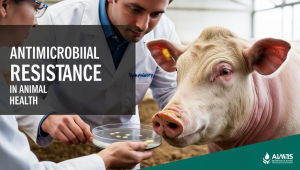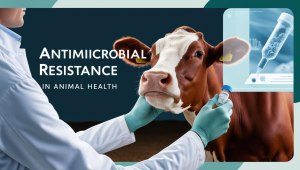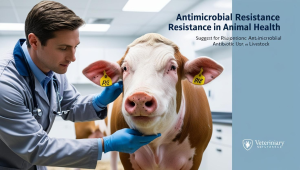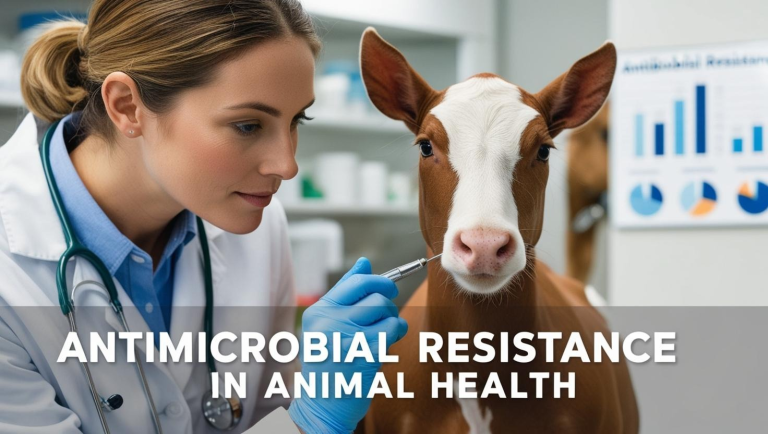Antimicrobial resistance (AMR) is one of the most pressing global health concerns affecting both human and animal populations. In animal health, the widespread use of antibiotics and other antimicrobial agents in livestock and poultry has contributed to the emergence and spread of resistant pathogens. This issue poses serious threats to food security, public health, and the effectiveness of disease treatment in animals. Understanding the causes, consequences, and mitigation strategies of AMR in animal health is essential for ensuring sustainable livestock production and protecting human health.
Understanding Antimicrobial Resistance (AMR)
Click HERE to join our WhatsApp group chat
a) What is Antimicrobial Resistance?
AMR occurs when microorganisms such as bacteria, viruses, fungi, and parasites develop the ability to survive exposure to antimicrobial drugs designed to kill them.
Resistant microbes continue to multiply, making infections harder to treat and increasing the risk of disease spread, severe illness, and death.
b) How Does AMR Develop?
AMR develops through genetic mutations or the acquisition of resistance genes from other bacteria.
The misuse and overuse of antimicrobials accelerate the emergence of resistant strains.
Resistant microbes can transfer resistance genes to other bacteria through horizontal gene transfer mechanisms such as conjugation, transformation, and transduction.
Causes of Antimicrobial Resistance in Animal Health

a) Overuse and Misuse of Antibiotics
The excessive use of antibiotics in livestock and poultry for growth promotion, disease prevention, and treatment contributes significantly to AMR.
Inadequate veterinary oversight leads to the indiscriminate use of antibiotics, sometimes without proper diagnosis.
b) Subtherapeutic Use in Animal Feed
Antibiotics are often included in feed at low doses to enhance growth and feed efficiency.
Prolonged exposure to low-dose antibiotics allows bacteria to develop resistance over time.
c) Poor Farm Management and Biosecurity
Unsanitary living conditions, overcrowding, and poor ventilation increase disease outbreaks, leading to higher antibiotic use.
Weak biosecurity measures enable the spread of resistant bacteria between animals and farms.
d) Lack of Adherence to Withdrawal Periods
Antibiotic residues in meat, milk, and eggs can enter the human food chain if withdrawal periods are not followed.
Ingesting antibiotic residues can contribute to resistance development in human gut microbiota.
e) Environmental Contamination
Antibiotic residues excreted by animals contaminate soil, water, and plants.
Resistant bacteria can spread from farms to the environment, increasing the risk of AMR transmission.
READ ALSO: The Role of Water in Livestock Production
Impact of AMR in Animal Health and Livestock Production

a) Increased Treatment Failures
AMR reduces the effectiveness of antibiotics, making common infections harder to treat.
Farmers face economic losses due to higher mortality rates and increased veterinary costs.
b) Threat to Food Safety and Public Health
Resistant bacteria can be transmitted from animals to humans through contaminated food products.
Zoonotic pathogens such as Salmonella, Escherichia coli, and Campylobacter can cause severe infections in humans.
c) Economic Consequences for Farmers
Rising treatment costs and reduced productivity affect farm profitability.
Trade restrictions on antibiotic-laden meat and animal products impact international markets.
d) Environmental Risks
Resistant bacteria in manure and wastewater can spread to wildlife, crops, and water sources.
This contributes to a larger AMR cycle affecting multiple ecosystems.
Strategies to Combat Antimicrobial Resistance in Animal Health
a) Prudent Use of Antibiotics
Antibiotics should be used only under veterinary supervision and based on proper diagnosis.
Avoid using antibiotics for growth promotion and indiscriminate disease prevention.
b) Improved Farm Management and Biosecurity
Enhanced hygiene, vaccination programs, and proper housing conditions can reduce the need for antibiotics.
Disease prevention through biosecurity minimizes the spread of infectious agents.
c) Development and Use of Alternatives
Probiotics and Prebiotics: Promote gut health and strengthen immunity in livestock.
Phytogenic Feed Additives: Plant-derived compounds, such as essential oils, possess antimicrobial properties.
Organic Acids and Enzymes: Improve digestion and nutrient absorption, reducing disease susceptibility.
Vaccination: Prevents bacterial infections and reduces the need for antibiotic treatments.
READ ALSO: Blackhead Disease in Turkeys: Causes, Symptoms, Prevention, and Treatment
d) Implementation of One Health Approach
The One Health concept integrates human, animal, and environmental health strategies to tackle AMR holistically.
Collaboration among veterinarians, farmers, policymakers, and public health officials is crucial.
e) Strict Regulatory Measures and Policies
Governments and global organizations (WHO, FAO, WOAH) enforce regulations to restrict antibiotic use in animal production.
Bans on antibiotic growth promoters and implementation of antibiotic stewardship programs promote responsible usage.
Role of Farmers, Veterinarians, and Consumers

a) Role of Farmers
Implement best farm management practices to reduce disease occurrence.
Follow proper antibiotic withdrawal periods to ensure food safety.
b) Role of Veterinarians
Prescribe antibiotics judiciously and promote alternative disease prevention measures.
Educate farmers on antimicrobial resistance and responsible antibiotic use.
c) Role of Consumers
Demand antibiotic-free and sustainably raised animal products.
Support farms and brands that prioritize responsible antibiotic use.
READ ALSO: Fermented Feeds and Their Benefits in Animal Nutrition
Global Efforts in Combating AMR in Animal Health
a) World Health Organization (WHO) Initiatives
WHO’s Global Action Plan on AMR promotes prudent antibiotic use and surveillance.
Recommendations include phasing out medically important antibiotics for non-therapeutic use in animals.
b) World Organisation for Animal Health (WOAH) Strategies
Encourages responsible antimicrobial use in veterinary medicine.
Provides guidelines for monitoring and reporting AMR in animal populations.
c) European Union (EU) Regulations
Bans the use of antibiotic growth promoters in livestock.
Enforces strict monitoring of antibiotic residues in food products.
d) U.S. Food and Drug Administration (FDA) Guidelines
Requires veterinary prescriptions for medically important antibiotics in livestock.
Promotes antibiotic-free meat production through voluntary industry initiatives.
Conclusion
Antimicrobial resistance in animal health is a growing threat that requires urgent attention from farmers, veterinarians, policymakers, and consumers. The overuse and misuse of antibiotics in livestock and poultry contribute to the emergence of resistant bacteria, which can spread to humans through food and the environment. Sustainable livestock practices, responsible antibiotic use, improved farm management, and the adoption of alternative treatments are critical in mitigating AMR. By implementing a One Health approach and adhering to global regulations, we can safeguard both animal and human health while ensuring the long-term sustainability of livestock production.
READ ALSO: Duck Plague: Prevention and Management
Duck Plague, also known as Duck Viral Enteritis (DVE), is a highly contagious and deadly disease affecting domestic and wild ducks. It is caused by the Anatid herpesvirus 1 (AnHV-1) and is characterized by high mortality, severe internal hemorrhages, and significant economic losses in duck farming. Effective prevention and management strategies are crucial in controlling the spread of this disease and ensuring the sustainability of duck farming operations…
READ ALSO: Artificial Insemination in Livestock and Poultry
Artificial Insemination (AI) is a widely used reproductive technology in livestock and poultry farming that involves the manual deposition of semen into the reproductive tract of a female animal using specialized equipment. AI has revolutionized breeding programs by improving genetic quality, enhancing productivity, and controlling diseases…
Click HERE to join our WhatsApp group chat

